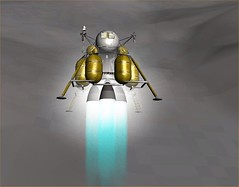
I’ve been busy with work and with doing space stuff in Orbiter. On the Orbiter side, I’ve been finishing the second edition of Go Play In Space (and beta testing the upcoming 2006 release of Orbiter in connection with this), and working with a team on an Orbiter simulation of the MarsDrive Consortium’s Mars for Less reference mission. Mars for Less has been developed by Grant Bonin as a modular variation of Dr. Robert Zubrin’s well-known Mars Direct approach, and Grant will be presenting a paper on the mission design this coming week at ISDC 2006 in Los Angeles.
Wrapped up in real work and virtual space, I missed a big story on the real side of space, and I’m grateful to Grant for pointing this out. On March 15, Dr. John Marburger, Director of the White House Office of Science and Technology Policy (OSTP) gave a major speech at the 44th Robert H. Goddard Memorial Symposium in Greenbelt, Maryland. In it, he revisited President Bush’s 2004 Vision for Space Exploration (VSE), and spelled out more clearly that a major question answered by VSE is “whether we want to incorporate the Solar System in our economic sphere, or not.”
The VSE’s answer is “yes,” and Dr. Marburger goes on to justify the focus on the Moon as a crucial step, because it and its resources are fairly close at hand, and more importantly, lie far from the bottom of Earth’s deep gravity well. And “resources” are key, because he also talks about how our space program must be made to serve the goals of scientific, security, and economic interests. It is not only about science, although that is part of it, it’s about making space serve the interests of the people of the US, and mankind in general. It’s a long-run view that is really quite progressive, even (dare I say) visionary. It does put Mars on a distant back burner, which is disappointing but also unfortunately realistic from the perspective of an economic return – I’m all for someone going to Mars as soon as they can, but Mars is quite far away and getting there will require solving many more problems than getting back to the Moon (maybe someone will solve those problems before NASA gets to them).
The speech also puts into perspective the reductions in NASA’s budget for science programs – for one thing, I was surprised to learn that due to unexpected successes in the lifetimes of many spacecraft (e.g., the Mars Rovers), that the US currently has 55 viable spacecraft requiring operations support. There are also relative increases for certain non-space science areas important to US competitiveness (DOE, NSF, NIST). These factors (in addition to continued support for the ISS and Shuttle, and development of next generation manned spacecraft) certainly put pressure on NASA’s budget, and a 3% increase just can’t cover everything. Should NASA have gotten more? In part this is a ROI question – would the American people get a good return by investing more in NASA? I don’t know, but the 3% and this speech certainly show the Administration’s opinion.
There is more to it – it’s a good speech. Such a speech from the OSTP director could be seen simply as one of the President’s men defending the President’s policies, and at one level, it is. But at another level, it makes the case that the VSE really is visionary, setting the stage for making the Solar System part of our practical world. Whether NASA will be able to pull it off, and whether future administrations will support its goals, I don’t know. But it goes far beyond footprints and flags and is extremely space-positive. I rarely give him credit for much, but I do have to give the President credit for pointing us in a spacefaring direction.
There was also an interesting analysis of this speech by Dennis Wingo on Saturday in SpaceRef.com.
No comments:
Post a Comment